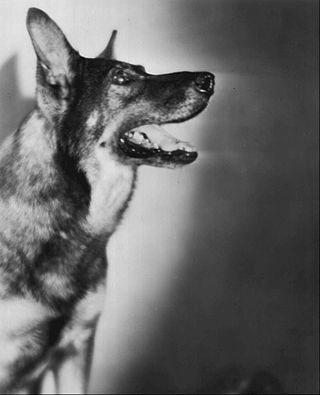
Rin Tin Tin or Rin-Tin-Tin was a male German Shepherd born in Flirey, France, who became an international star in motion pictures. He was rescued from a World War I battlefield by an American soldier, Lee Duncan, who nicknamed him "Rinty". Duncan trained Rin Tin Tin and obtained silent film work for the dog. Rin Tin Tin was an immediate box-office success and went on to appear in 27 Hollywood films, gaining worldwide fame. Along with the earlier canine film star Strongheart, Rin Tin Tin was responsible for greatly increasing the popularity of German Shepherd dogs as family pets. The immense profitability of his films contributed to the success of Warner Bros. studios and helped advance the career of Darryl F. Zanuck from screenwriter to producer and studio executive.
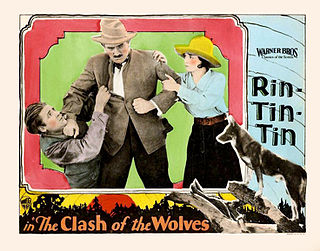
The Clash of the Wolves is a 1925 American silent Western film produced and distributed by Warner Bros. Directed by Noel M. Smith, the film stars canine actor Rin Tin Tin, Charles Farrell and June Marlowe. It was filmed on location in Chatsworth, California, and at what would later become the Joshua Tree National Park. It was transferred onto 16mm film by Associated Artists Productions in the 1950s and shown on television. A 35mm print of the film was discovered in South Africa and restored in 2003. In 2004, The Clash of the Wolves was deemed "culturally, historically, or aesthetically significant" by the United States Library of Congress and selected for preservation in the National Film Registry.

Don Juan is a 1926 synchronized sound American romantic adventure film directed by Alan Crosland. It is the first feature-length film to utilize the Vitaphone sound-on-disc sound system with a synchronized musical score and sound effects, though it has no spoken dialogue. The film is inspired by Lord Byron's 1821 epic poem of the same name. The screenplay was written by Bess Meredyth with intertitles by Maude Fulton and Walter Anthony.

While London Sleeps is a 1926 Warner Bros. film about a police-dog, Rinty, who helps Scotland Yard defeat a dangerous criminal organisation known as the Mediterranean Brotherhood that operates out of the Limehouse district of London. While the film has no audible dialog, it was released with a synchronized musical score with sound effects using the Vitaphone sound-on-disc process. Walter Morosco wrote the screenplay. It was the first of many films directed by Howard Bretherton, and one of several created for Rin Tin Tin, a German Shepherd dog used in films during the 1920s and 1930s. Only the sound discs to the film survive today with the visual film portions being lost. The British release prints censored the more horrific aspects of the film.

Why Be Good? is a 1929 American sound comedy film produced by First National Pictures starring Colleen Moore and Neil Hamilton. While the film has no audible dialogue, it is accompanied by a Vitaphone soundtrack that features a musical score with sound effects and some synchronized singing.
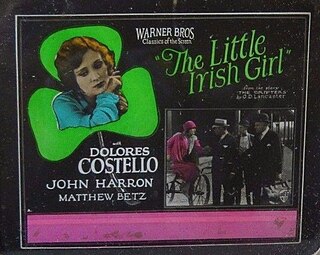
The Little Irish Girl is a 1926 American silent romantic drama film produced and distributed by Warner Bros., directed by Roy Del Ruth and starring Dolores Costello. Based on the story The Grifters, written by Edith Joan Lyttleton, it is considered to be a lost film.

The Lighthouse by the Sea is a 1924 American silent adventure film produced by and distributed by Warner Bros. The film's star is canine sensation Rin Tin Tin, the most famous animal actor of the 1920s. The film was directed by Malcolm St. Clair.

Where the North Begins is a 1923 American silent drama film produced and distributed by Warner Bros. This was the third film for up-and-coming canine actor Rin Tin Tin. The film survives today and lapsed into the public domain on January 1, 2019, along with all remaining American works from 1923 that had not yet lapsed.

Tracked by the Police is a 1927 silent film produced and distributed by the Warner Bros. with a story written by Darryl Zanuck. It stars canine actor Rin Tin Tin. Ray Enright directed the film with 'Rinty's' costars being Jason Robards, Sr. and Virginia Brown Faire. The film may have had a Vitaphone sound effects/music track that is now lost. The film is preserved at the Library of Congress.
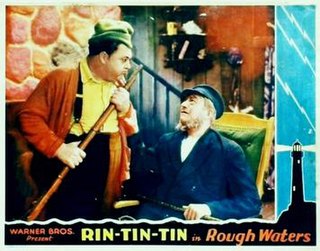
Rough Waters is a 1930 American pre-Code all-talking adventure drama film that directed by John Daumery and starring Rin Tin Tin. The film was adapted by James A. Starr from a story by Lillie Hayward, and was the last Rin Tin Tin film produced by Warner Bros.

A Dog of the Regiment is a 1927 American synchronized sound drama film directed by D. Ross Lederman. While the film has no audible dialog, it was released with a synchronized musical score with sound effects using the Vitaphone sound-on-disc process. This film is presumed lost. According to Warner Bros records the film earned $188,000 domestic and $59,000 foreign, against a budget of $76,000.

A Race for Life is a 1928 American synchronized sound drama film directed by D. Ross Lederman. While the film has no audible dialog, it was released with a synchronized musical score with sound effects using the sound-on-disc Vitaphone process. Originally, the film was presumed to be lost. However, according to the Library of Congress Database, the film was found in the Netherlands. The film was released with a Vitaphone soundtrack with a synchronised musical score and sound effects.

Rinty of the Desert is a 1928 American synchronized sound drama film directed by D. Ross Lederman. While the film has no audible dialog, it was released with a synchronized musical score with sound effects using the sound-on-disc Vitaphone process. This film is presumed to be lost. According to Warner Bros records, the film earned $164,000 domestically and $57,000 foreign.
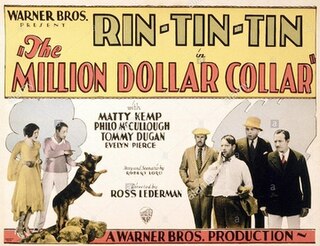
The Million Dollar Collar is a 1929 American sound part-talkie crime film directed by D. Ross Lederman. In addition to sequences with audible dialogue or talking sequences, the film features a synchronized musical score and sound effects along with English intertitles. The soundtrack was recorded using the Vitaphone sound-on-disc system. The film is in unknown status which suggests that it may be lost. According to Warner Bros records the film earned $222,000 domestically and $90,000 foreign.
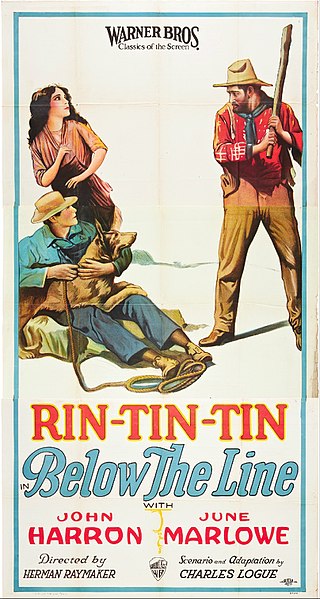
Below the Line is a 1925 American silent drama film featuring canine star Rin Tin Tin and directed by Herman C. Raymaker. It was produced and distributed by Warner Bros.

Frozen River is a lost 1929 sound part-talkie film directed by F. Harmon Weight and starring the canine star Rin Tin Tin and boy actor Davey Lee. In addition to sequences with audible dialogue or talking sequences, the film features a synchronized musical score and sound effects along with English intertitles. The soundtrack was recorded using the Vitaphone sound-on-disc system. Warner Bros. produced and distributed the film.

Jaws of Steel is a 1927 American synchronized sound family adventure film directed by Ray Enright and featuring dog star Rin Tin Tin and Jason Robards Sr. While the film has no audible dialog, it was released with a synchronized musical score with sound effects using the Vitaphone sound-on-disc process. Warner Bros. produced and distributed the film. Darryl F. Zanuck, under the alias Gregory Rogers, wrote the story. The film is in the public domain in the United States.

A Hero of the Big Snows is a 1926 American silent adventure film directed by Herman C. Raymaker and written by Ewart Adamson. The cast includes canine actor Rin Tin Tin. The film also stars Alice Calhoun, Don Alvarado, Leo Willis and Mary Jane Milliken. The film was released by Warner Bros. on July 24, 1926.
Hills of Kentucky is a 1927 American silent drama film directed by Howard Bretherton and written by Edward Clark. The film stars Rin Tin Tin, Jason Robards, Sr. and Dorothy Dwan. The silent film was released by Warner Bros. on February 19, 1927, with a synchronized musical score.
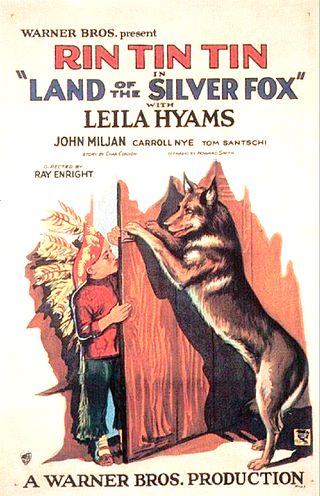
Land of the Silver Fox is a 1928 sound part-talkie American adventure film directed by Ray Enright and written by Howard Smith and Joseph Jackson. In addition to sequences with audible dialogue or talking sequences, the film features a synchronized musical score and sound effects along with English intertitles. The soundtrack was recorded using the Vitaphone sound-on-disc system. The film stars Rin Tin Tin, Leila Hyams, John Miljan, Carroll Nye, Tom Santschi, and Neola May. The film was released by Warner Bros. on October 18, 1928.


















